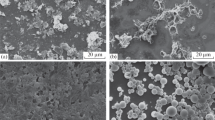Abstract
A series of novel epoxy polymer shell microcapsules with n-tetradecane and dimethylbenzene as binary core materials are successfully synthesized via interfacial polymerization. Dimethylbenzene is used as the solvent for epoxy and n-tetradecane. The chemical structure, surface morphology, and thermal properties of the microencapsulated phase-change materials (micro-PCMs) are characterized by Fourier transform infrared spectroscopy, differential scanning calorimetry, thermogravimetric analysis, scanning electron microscopy, and transmission electron microscope. Results show that the micro-PCMs have relatively spherical profiles and smooth surfaces with diameters ranging from 10 to 70 μm. The epoxy shell successfully encapsulates the binary core. Phase-change enthalpy and binary core content in the micro-PCMs increase with the increasing mass ratio of the binary core to the epoxy resin. The micro-PCMs degrade in two steps, and the resulting microcapsules exhibit good thermal stabilities. The degradation temperature decreases, as the core-to-shell mass ratio increases.






Similar content being viewed by others
References
Zhou ZH, Zhang ZM, Zuo J, Huang K, Zhang LY (2015) Phase change materials for solar thermal energy storage in residential buildings in cold climate. Renew Sust Energ Rev 48:692–703
Aadmi M, Karkri M, EI Hammouti M (2015) Heat transfer characteristics of thermal energy storage for PCM (phase change material) melting in horizontal tube: numerical and experimental investigations. Energy 85:339–352
Iqbal K, Sun DM (2014) Development of thermo-regulating polypropylene fibre containing microencapsulated phase change materials. Renew Energ 71:473–479
Memon SA, Cui HZ, Lo TY, Li QS (2015) Development of structural-functional integrated concrete with macro-encapsulated PCM for thermal energy storage. Appl Energ 150:245–257
Wu WF, Liu N, Cheng WL, Liu Y (2013) Study on the effect of shape-stabilized phase change materials on spacecraft thermal control in extreme thermal environment. Energ Convers Manage 69:174–180
Wang Y, Zhang Y, Xia TD, Zhao WJ, Yang WH (2014) Effects of fabricated technology on particle size distribution and thermal properties of stearic-eicosanoic acid/polymethylmethacrylate nanocapsules. Sol Energ Mat Sol C 120:48–90
Konuklu Y, Paksoy HO, Unal M, Konuklu S (2014) Microencapsulation of a fatty acid with poly (melamine-urea-formaldehyde). Energ Convers Manage 80:382–390
Sari A, Alkan C, Altintas A (2014) Preparation, characterization and latent heat thermal energy storage properties of micro-nanoencapsulated fatty acids by polystyrene shell. Appl Therm Eng 73:1160–1168
De Castro PF, Shchukin DG (2014) New polyurethane/docosane microcapsules as phase-change materials for thermal energy storage. Chem-Eur J 21:11174–11179
Chen ZH, Wang JC, Yu F, Zhang ZG, Gao XN (2014) Preparation and properties of graphene oxide-modified poly(melamine-formaldehyde) microcapsules containing phase change material N-dodecanol for thermal energy storage. J Mater Chem A 3:11624–11630
Yang T, Wang R, Hou XQ, Cheng J, Zhang JY (2016) Morphology and high-performance of in situ self-assemble epoxy resin with side aliphatic dangling chains. Mater Lett 166:150–153
Wu X, Yang X, Zhang Y, Huang W (2016) A new shape memory epoxy resin with excellent comprehensive properties. J MaterSci 51:3231–3240
Datta J, Wloch M (2015) Selected biotrends in development of epoxy resins and their composites. Polym Bull 71:3035–3049
Jilani W, Mzabi N, Fourati N, Zerrouki C, Gallot-Lavallee O, Zerrouki R, Guermazi H (2015) Effects of curing agent on conductivity, structural and dielectric properties of an epoxy polymer. Polymer 79:73–81
Sanchez-Silva L, Tsavalas J, Sandberg D, Sanchez P, Rodriguez JF (2010) Synthesis and characterization of paraffin wax microcapsules with acrylic-based polymer shells. Ind Eng Chem Res 49:12204–12211
Acknowledgments
This research is supported by the China Postdoctoral Science Foundation (No. 2015M572513) and the Fundamental Research Funds for the Central Universities (No. 310821151010).
Author information
Authors and Affiliations
Corresponding author
Rights and permissions
About this article
Cite this article
Wei, K., Ma, B., Wang, H. et al. Synthesis and thermal properties of novel microencapsulated phase-change materials with binary cores and epoxy polymer shells. Polym. Bull. 74, 359–367 (2017). https://doi.org/10.1007/s00289-016-1718-z
Received:
Revised:
Accepted:
Published:
Issue Date:
DOI: https://doi.org/10.1007/s00289-016-1718-z




